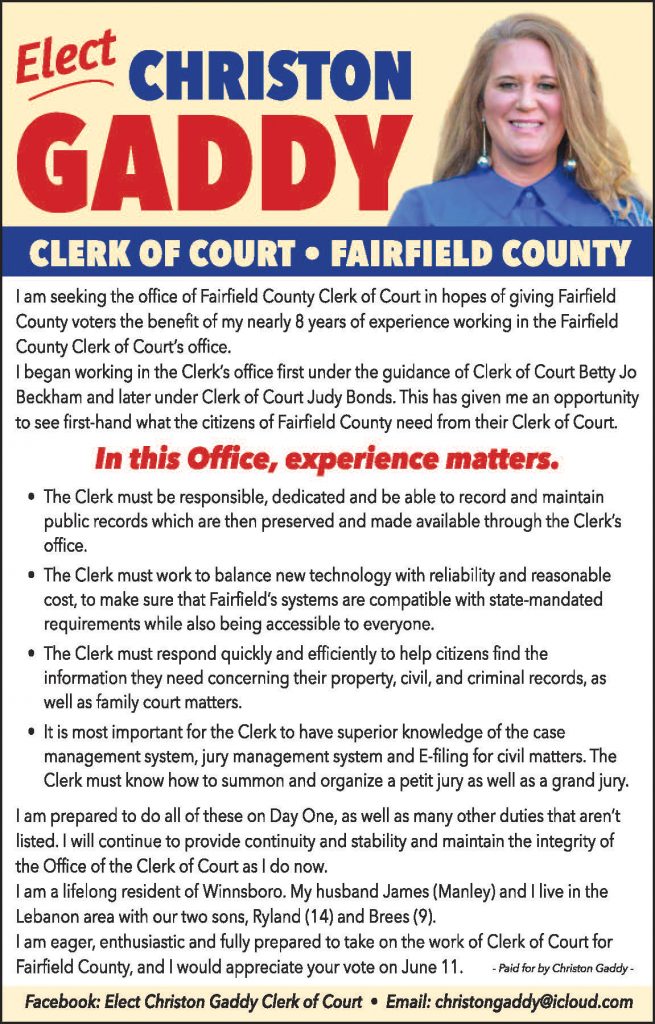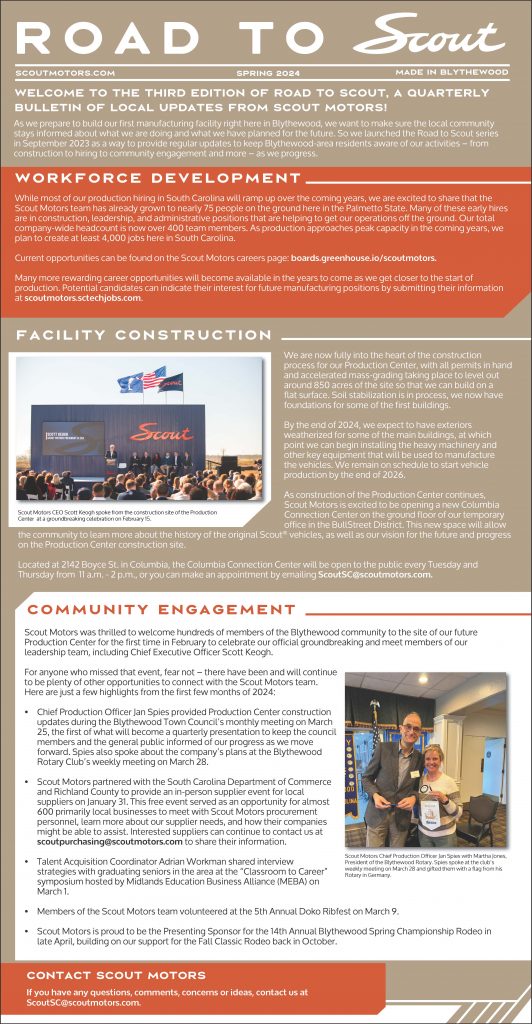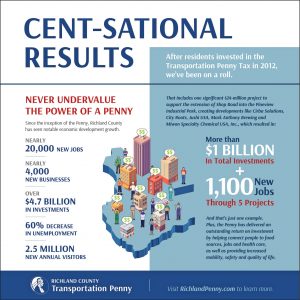WINNSBORO – The Voice has received several letters from readers in regard to the penny tax and the wastewater treatment plant that ask some of the same questions that have also been posed on Facebook pages by citizens in both Fairfield County and Blythewood (Cedar Creek area.) The Voice asked county officials s to answer these questions and clarify any misinformation. While county officials can provide information about the penny tax, they cannot advocate for or against it. Questions that might be construed as advocating were answered by Gene Stevens, President of the Fairfield Chamber of Commerce or Neil Robinson, County Council Chairman.
Q: Since Chamber is on the taxpayer’s payroll and it is illegal for County taxes to be used to promote the penny tax…there appears to be a serious conflict of interest.
A: The Chamber is not on the County’s payroll. The County grants the Chamber funds every budget year for various purposes, mostly to promote tourism and business activity such as the Ag & Art Tour. Rock Around the Clock, etc. The County’s funds are not being used to promote the Penny sales Tax. The Fairfield Chamber of Commerce is a 501 C6 organization which gives them the right to advocate on any issue they view fit. “501 C6 tax status is that it allows organizations to engage in unlimited amounts of lobbying.” No Chamber dues, County or Town funds were used in funding this effort. It was all raised by outside sources. No employees at the Fairfield Chamber of Commerce are County employees.
Q: Shouldn’t a potential industry pay for the WWTP it needs?
A: They do through impact fees. However, the waste water treatment plant must be in place first.
Without proper infrastructure, companies will not establish job creating, tax paying facilities.
Industries pay impact fees to connect to the system along with usage rates. Impact Fees or tap fees based on volume and are similar to what residential customers pay when they build a new house and connect to a municipal system.
Q: Now, the county is asking Fairfield County residents, and me when I shop there, to pay a 14 percent tax on nearly everything that we buy in the county or you order on line.
A: This is not true. This is an extremely misleading tactic used repeatedly by people opposed to sales tax increases across the country. Claiming the county’s penny tax brings the sales tax in Fairfield County to a 14% sales tax increase is disingenuous and not at all accurate.
The following explanation we think gives a good understanding of how the tax works.
“Though 14 percent is the mathematical rise in the rate of fractional rate charged, it does not accurately convey the impact of the tax because it is a comparison of fractional rates and includes no whole numbers. To determine the true percentage increase, the formula used must include the real-world cost of goods involved. For example, the current sales tax on a qualifying $10 purchase [in Fairfield County] is .70 cents. If the referendum is approved, the same item would cost $10.80. To calculate the increase, subtract the current cost from the proposed cost ($10.80- $10.70 = 0.1) and divide the difference by the current cost (0.1 ÷ 10.70 = 0.009345). To convert the answer to a percentage, multiply the quotient by 100 (0.009345 x 100 = 0.93), and the product is rounded to 1 percent.” – Larry Wood, Post and Courier
Put simply, assume you choose to visit Laura’s Tea Room in Ridgeway and you spend $10.00 on great sandwich plate and a cup of tea, your additional cost due to the penny sales tax is ten cents. If you add the existing 6% state sales tax and the 1% road tax, your total cost would be $10.80, not $11.40 which is what you would pay if a 14% sales tax were imposed, which is not the case.
That’s why the 14% increase statement is a misleading tactic.
Now assume you spent $10.00 on a sandwich in Blythewood at Scotties. In Richland County, your total costs would be $11.00…twenty cents more than Fairfield County. Richland County charges 2% more on every dollar spent which you can see from our above response is not a 28% increase.
Another thing important to note is that this 1% sales tax isn’t applied to non-prepared food (groceries) or any medicine, so to say “a 14 percent tax on nearly everything that we buy” is not true on two levels.
The real issue is not the additional minimal impact of a 1% increase on local citizens but the significant burden of high unemployment, lack of amenities, and a dismal future for our kids without the 1% increase. Remember, for the last twenty years, we have been burdened with the highest unemployment in the state. Just prior to Covid, as a result of our commitment to economic development efforts, our unemployment rate plummeted and there were at least nine other counties with higher rates. In the last 18 months, we have announced more jobs than in the previous 15 years combined. We have momentum and sewer capacity is absolutely foundational to the future that our citizens and our children deserve. Neil Robinson, Chair Fairfield County Council.
Q: [The county has] 16 properties on the I-77 Corridor internet site for sale or lease. Two spec. buildings built in 2014 that have never been used. They have 600 acres on Cook road in industrial Park sitting there empty.
A: This is not true. To begin, the first spec building that was built in Walter B. Brown Industrial Park was sold to a company called CTG. They currently use the facility as a distribution warehouse. The second Spec Building you are referring to has been sold to Oldcastle APG who plans to invest $28.9 million and begin operating out of the facility by Q1 of 2021. They will hire around 100 employees and pay hundreds of thousands of dollars per year in property taxes.
The Fairfield County Commerce Center is still in the process of being developed. The first tenant was Bomag. Currently we have other prospects considering the park. Incidentally, they initially looked at Fairfield County because of the speculative building. We recently received grant funding to pre-grade sites for prospective industry. Even during Covid, we are experiencing significant interest.
Q: No Fairfield residents are receiving new sewer from this 50 million dollar spec. plant
A: The plant is estimated to cost $32 million. Most of which will be offset by grant funding. Initially, we will extend collection lines along major arteries to allow residents to connect. We are pursuing new residential and commercial development as aggressively as industrial activity.
Q: Not a SINGLE WWTF in SC has contained spills. NOT ONE!
A: This is misleading. The MBR system, which is the proposed facility, has recorded no leaks in the wwtp located in Isle of Palms. We propose to build the same kind of state-of-the-art all enclosed wastewater treatment plant.
Q: There has been NO CONSIDERATION on the impact on animals like deer, turkey, raccoons, possums and thousands of birds that will consume the effluent and eventually get sick and die
A: This is not true. Studies have been conducted on the impacts to the area and the creek. DHEC has approved Cedar Creek as capable for accepting the discharge. Cedar Creek already accepts effluent from the Ridgeway Waste Water Facility and we are unaware of any adverse impact on wildlife. As has been stated multiple times, the MBR system generates a very clean effluent. In fact, it is near potable.
Q: How many think that locating sports areas near a wastewater plant is a fun place to play?!
A: First, the plant itself will not be located directly by the fields. The proposed exhibit you a referencing has the plant at the southern end of the property. Between the plant and the fields, there will be significant vegetative buffer, meaning that the plant itself will not be visible. The grading work that will be done on site will make it so the plant will be lower than the ball fields. In addition the plant itself is a relatively small MBR (Membrane Bio Reactor) system. The entire facility will be enclosed.
Also, the Columbia Waste Water Facility is located adjacent to the exclusive private Heathwood Hall Episcopal School which has numerous outdoor recreational activities including sports fields.
Camden recently opened their Riverfront Environmental Park. This was a former sewer facility pond site and is also located by the existing waste water facility. Camden received a Municipal Association of South Carolina (MASC) Achievement Award for this park. 30 cities and towns submitted projects and initiatives for consideration in the annual award.
Q: Had they [county] set aside the money that they have spent on this [Penny Sales Tax] PR campaign and design, how much closer would they be in getting the wastewater where it needs to go – into the Broad River.
A: The county is not participating in any advocacy campaign. The Fairfield Chamber of Commerce is running an advocacy campaign that has been paid for by donations from private organizations. As previously stated, the Fairfield Chamber of Commerce is an 501 C6 organization. 501 C6 organizations can participate in advocacy work. 501 C6 tax status allows organizations to engage in unlimited amounts of lobbying. Executive advocacy comprises a significant portion of the activities of many business leagues. Zero county dollars have been spent on any PR campaign for the Penny Sales Tax.
Fairfield County has only hosted an educational Zoom meeting.
Q: The effluent will contaminate the water wells along Cedar Creek.
A: No. And to be clear, Ridgeway’s existing facility already discharges effluent into Cedar Creek now and has for years. Out of concern for the wells, the county requested a hydrologist study the potential impacts on groundwater. The study concluded that there were no ramifications. If you have interest in looking at the study please reach out to the Economic Development office. We can make that available for anyone who wants to read through it.
Conclusions of the study are as follows:
In the South Carolina Piedmont, water does not flow across topographic divides. Instead it flows within the watershed via relatively short distances from topographic divides toward stream channels.
Streams in the Piedmont Province are characteristically referred to as “gaining” streams because the streams gain water from discharging groundwater along their length; thus. The Piedmont aquifer feeds flow to streams rather than streams feeding the aquifer.
Although there are rare instances of “losing” streams (streams that discharge water to groundwater) in the Piedmont Province, they are usually associated with specific rock types like limestone or dolomite, which are not mapped within the Big Cedar Creek watershed.
Water in Piedmont watersheds invariably flows from high elevations to low elevations, and toward the stream network. This flow pattern includes subsurface groundwater flow.
The chance of recovered well water being influenced by surface water is remote, because the volume of water pumped for domestic water supply needs is miniscule compare to the volume of water traveling within the watershed from stream divides toward streams.
Q: Why can’t the wastewater treatment plant wait till a later time?
A: Fairfield County will be unable to attract any new industry without an expansion of sewer capacity.
We are almost out of capacity now. We must continue to lure investment and add jobs as well as curb the trend of population decline in Fairfield County.
Q: Did the county pay the newspaper or a PR firm to write the story on the wastewater plant/sports complex?
A: No
Q: If the penny tax passes, how much total sales tax will residents be paying?
A: One penny on every dollar spent, ten cents on every ten dollars spent and one dollar on every hundred dollars spent.
Q: In The Voice article, county officials said there is only 34,000 gallons per day of sewer capacity available. The Town of Winnsboro has an available capacity of 287,000 gallons per day, and capacity from closed industries would contribute another 255,000 gallons per day.
A: Officials have said there is only 34,000 gpd available at the mega site, Fairfield Commerce Center, Exits 32 and 34. The existing collection lines and pump stations are inadequate, undersized, out dated and in need of upgrading. In order for the growth areas to access Winnsboro’s excess capacity, we would have to spend $10M-$12M on collection lines. Conservatively, we can build a plant to initially handle 2 mgd and easily expand to 4 mgd for $8-16 per gallon. Economically, it makes no sense to spend $12M to upgrade sewer collection lines and not create any new sewer capacity.
The Winnsboro engineers did identify 255,000 gpd that can be potentially “reclaimed,“ but DHEC has not yet signed off on this request. Until they do, there is only 287,000 gpd available, but not accessible.












